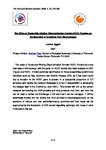The Effect of Nucleotide-binding Oligomerization Domain (NOD) Proteins on the Secretion of Cytokines from Macrophages
| dc.contributor.author | Aggett, J. | |
| dc.date.accessioned | 2018-11-08T13:46:34Z | |
| dc.date.accessioned | 2018-11-19T12:21:56Z | |
| dc.date.available | 2018-11-08T13:46:34Z | |
| dc.date.available | 2018-11-19T12:21:56Z | |
| dc.date.issued | 2008 | |
| dc.identifier.citation |
Aggett, J. (2008) 'The Effect of Nucleotide-binding Oligomerization Domain (NOD)', The plymouth Student Scientist, 1(1), p.312-330 | en_US |
| dc.identifier.issn | 1754-2383 | |
| dc.identifier.uri | http://hdl.handle.net/10026.1/12811 | |
| dc.description.abstract |
The study of Nucleotide-Binding Oligomerization Domain (NOD) Proteins is a very new area of immunology, with the gene for NOD2 having only been mapped in 2001 (Ogura et al 2001). It holds particular significance for those researching autoimmune disorders such as Blau syndrome and Crohns Disease (CD), as it has been found that a mutation in the NOD2 gene is present in a substantial proportion of CD sufferers, and having the mutation increases a person‟s susceptibility to developing the disease later in life (Economou et al 2004). This review will look at the current research surrounding the NOD proteins and what products they form, and how this can be used to further our knowledge of CD and how it can be managed. It will be specifically looking into the effects that NOD proteins in macrophages have on the secretion of various pro- and anti-inflammatory cytokines and how these can be augmented by the interaction of NOD protein signalling pathways with those of other molecules in the cell. | en_US |
| dc.language.iso | en | en_US |
| dc.publisher | University of Plymouth | |
| dc.rights | Attribution 3.0 United States | * |
| dc.rights.uri | http://creativecommons.org/licenses/by/3.0/us/ | * |
| dc.title | The Effect of Nucleotide-binding Oligomerization Domain (NOD) Proteins on the Secretion of Cytokines from Macrophages | en_US |
| dc.type | Article | |
| plymouth.issue | 1 | |
| plymouth.volume | 1 | |
| plymouth.journal | The Plymouth Student Scientist |



